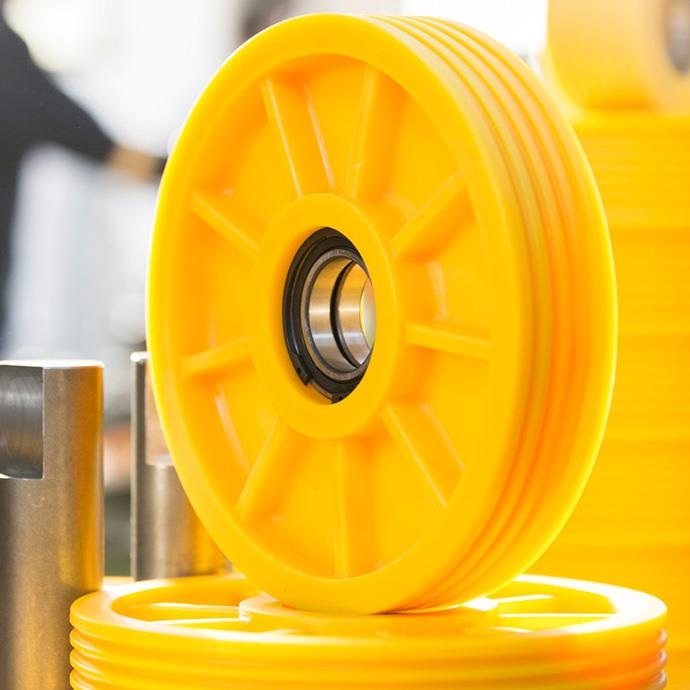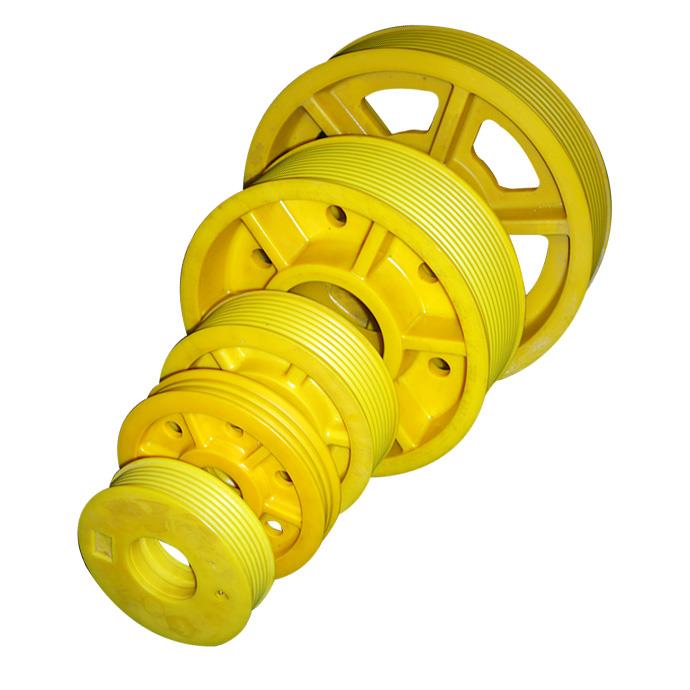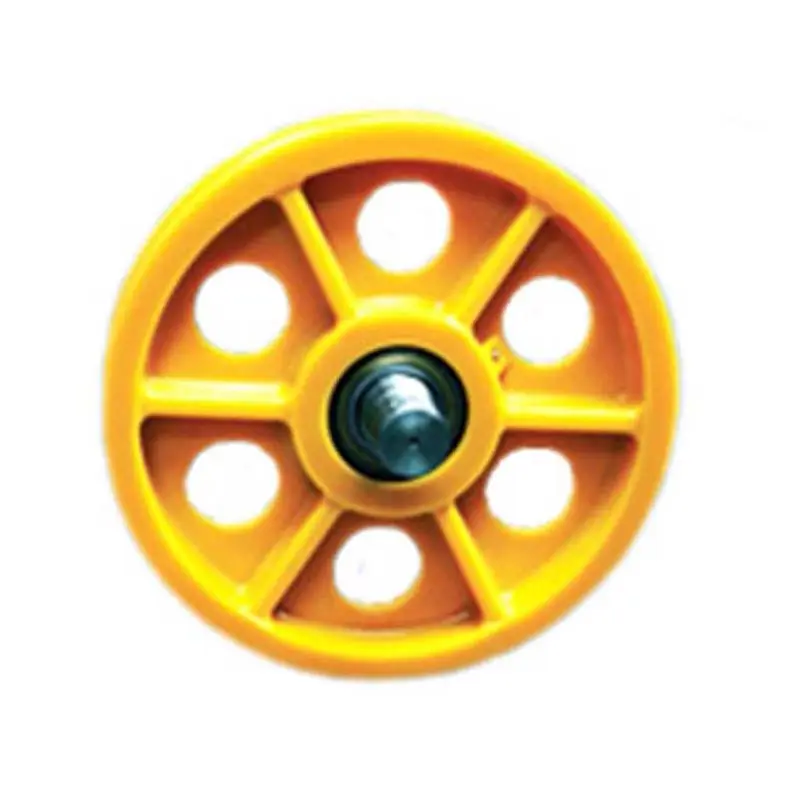Product Description
Sheave(external diameter Φ1100) features:
1) Material: Q235B, Q345B, 35#, 45#
2) Heat treatment :hardening and tempering,high frequency quenching,carburizing quenching and so on
3) Groove surface quench: HRC45-55
4) Groove surface quench depth: ≥2mm
5) Max processing diameter: 2,000mm
6) Short production period
7)Inspection:all items are checked and tested thoroughly during every working procedure and after the product is finally manufactured to ensure that best quality product goes out in the market.
8)good quality with reasonable price,timely delivery and great customer service.
| Code | Wire rope diameter(mm) | Main dimension(mm) | Weight for reference(kg) | ||||||
| D | D1 | R | b | W | D2 | B | |||
| BX1251 | 10-14 | 355 | 400 | 7 | 37 | 28 | 55 | 64 | 16 |
| BX2251 | >14-19 | 450 | 510 | 10 | 50 | 38 | 80 | 74 | 28 |
| BX3251 | >19-23.5 | 560 | 631 | 12 | 60 | 46 | 95 | 90 | 50 |
| BX4251 | >23.5-30 | 710 | 800 | 15 | 73 | 57 | 130 | 106 | 91 |
| BX5251 | >23.5-30 | 900 | 1012 | 19 | 92 | 72 | 160 | 128 | 158 |
| BX6251 | >30-37 | 1000 | 1126 | 22 | 104 | 82 | 160 | 128 | 200 |
| BX7251 | >43-50 | 1250 | 1402 | 26 | 123 | 98 | 190 | 148 | 394 |
| BX8251 | >50-58 | 1400 | 1572 | 29 | 135 | 110 | 190 | 148 | 504 |
About Us
As a company of industries and trading integration with ISO 9001-2008 Certificate, HangZhou CHINAMFG Metallurgy Equipment Manufacturing Co., Ltd. has been in manufacturing material handling equipment parts for many years, such as gears,wheels and sheaves and so on,with professional experience.
Our Service:
If you are interested in any of our products, please contact me freely! Warmly Welcomed your visit to our factory in China, OEM service will be ok.
| Pulley: | Lifting Equipment |
|---|---|
| Sheave: | Goods Crane |
| Transport Package: | Plywood Case |
| Specification: | 300mm-2000mm |
| Trademark: | baoxin |
| Origin: | Changzhou, China |
| Customization: |
Available
| Customized Request |
|---|

How do lifting pulleys contribute to the longevity and reliability of lifting equipment?
Lifting pulleys play a significant role in enhancing the longevity and reliability of lifting equipment. They contribute to the smooth functioning of the lifting system and help minimize wear and tear on various components. Here’s a detailed explanation of how lifting pulleys contribute to the longevity and reliability of lifting equipment:
1. Load Distribution: Lifting pulleys distribute the weight of the load evenly across the lifting system. By spreading the load over multiple ropes or cables, pulleys reduce the strain on individual components, such as cables, hooks, and attachments. This balanced load distribution minimizes the risk of overloading and premature failure of specific parts, thereby prolonging the lifespan of the lifting equipment.
2. Reduced Stress on Components: Lifting pulleys help to alleviate stress on various components of the lifting system. When lifting heavy loads, the force exerted on the cables or ropes can be substantial. By utilizing pulleys, the load is distributed across multiple ropes or cables, reducing the stress on each individual component. This reduction in stress helps prevent excessive stretching, bending, or breakage of cables, ensuring the reliability and longevity of the lifting equipment.
3. Efficient Force Transmission: Lifting pulleys facilitate efficient force transmission within the lifting system. As the load is distributed and redirected through the pulleys, the force is applied in a controlled and balanced manner. This efficient force transmission minimizes unnecessary strain on the lifting equipment and reduces the risk of sudden jerks or jolts that can cause damage or premature wear.
4. Improved Load Control: Lifting pulleys enable precise control over the lifting process, allowing operators to adjust the speed, direction, and position of the load with accuracy. This precise load control helps in preventing sudden or uncontrolled movements that can put stress on the lifting equipment. By ensuring smooth and controlled load handling, pulleys contribute to the longevity and reliability of the lifting equipment.
5. Reduction in Friction: Lifting pulleys are designed to minimize friction between the pulley and the ropes or cables. They often incorporate ball bearings or other low-friction mechanisms to ensure smooth rotation. By reducing friction, pulleys minimize wear on the ropes or cables, as well as on the pulley itself. This reduction in friction helps to extend the lifespan of the lifting equipment.
6. Protection Against Abrasion: Lifting pulleys can incorporate features such as protective coatings or linings to minimize abrasion and wear on the ropes or cables. These protective measures help prevent damage to the lifting equipment caused by repeated rubbing or contact with rough surfaces. By safeguarding against abrasion, pulleys contribute to the longevity and reliability of the lifting equipment.
7. Maintenance and Serviceability: Lifting pulleys are typically designed for easy maintenance and serviceability. They can be quickly inspected, lubricated, and replaced if necessary. Regular maintenance, including cleaning and lubrication of the pulleys, ensures their optimal performance and extends their lifespan. By facilitating routine maintenance, pulleys contribute to the overall reliability and longevity of the lifting equipment.
8. Compatibility and Interchangeability: Lifting pulleys are often designed to be compatible and interchangeable with various lifting systems and configurations. This compatibility allows for easy replacement or upgrading of pulleys as needed. Interchangeability ensures that pulleys can be seamlessly integrated into the existing lifting equipment, thereby extending its reliability and lifespan.
In conclusion, lifting pulleys play a crucial role in promoting the longevity and reliability of lifting equipment. Through load distribution, stress reduction, efficient force transmission, improved load control, friction reduction, protection against abrasion, maintenance and serviceability, as well as compatibility and interchangeability, pulleys contribute to the smooth functioning and extended lifespan of the lifting equipment.

What are some real-world examples of lifting pulley applications in construction projects?
Lifting pulleys are widely used in construction projects for various lifting applications. They enhance the efficiency and safety of lifting heavy loads, equipment, and materials. Here are some real-world examples of lifting pulley applications in construction:
1. Tower Crane Lifting: Tower cranes are commonly employed in construction projects to lift and move heavy materials and equipment vertically and horizontally. These cranes utilize lifting pulleys in their lifting mechanisms. The pulleys distribute the load’s weight, provide mechanical advantage, and enable precise control over the lifting process.
2. Mobile Crane Operations: Mobile cranes, such as truck-mounted or rough-terrain cranes, are versatile lifting equipment used in construction sites. Lifting pulleys are integral components of these cranes, specifically in their boom systems. The pulleys help lift heavy loads and position them accurately, facilitating efficient construction operations.
3. Elevator Installation: In construction projects involving multi-story buildings, elevators are essential for vertical transportation. Lifting pulleys are crucial components in elevator systems. They enable smooth and controlled movement of the elevator car, ensuring safe transportation of passengers or goods between floors.
4. Concrete Pumping: Concrete pumps are used to transport and pour concrete in construction projects. These pumps employ lifting pulleys to lift and position heavy concrete-filled hoses or booms. The pulleys facilitate precise pouring and placement of concrete, allowing for efficient construction processes.
5. Roofing Material Installation: Lifting pulleys are commonly used in construction projects for the installation of roofing materials. They assist in lifting heavy roofing materials, such as shingles or metal panels, to elevated locations. The pulleys help distribute the load’s weight and make it easier for workers to handle and position the roofing materials accurately.
6. Facade Installation: Lifting pulleys play a crucial role in the installation of building facades. They are used to lift and position large panels, glass sheets, or curtain wall components to the desired heights. The pulleys enable controlled movement and precise placement of the facade elements during installation.
7. Bridge Construction: Lifting pulleys are extensively utilized in bridge construction projects. They assist in lifting and positioning heavy bridge components, such as segments, beams, or precast elements. The pulleys distribute the load’s weight and enable precise control over the lifting process, ensuring safe and efficient bridge construction.
These are just a few examples of how lifting pulleys are applied in construction projects. Lifting pulleys offer versatility and adaptability, allowing them to be customized and integrated into various construction lifting systems. By incorporating lifting pulleys, construction projects can benefit from improved lifting capabilities, enhanced efficiency, and safer operations.

What types of materials are typically used in the manufacturing of lifting pulleys?
Lifting pulleys are manufactured using a variety of materials, depending on the specific application and desired characteristics. Here are some types of materials commonly used in the manufacturing of lifting pulleys:
1. Steel: Steel is one of the most widely used materials for lifting pulleys due to its excellent strength and durability. Different grades of steel, such as carbon steel or alloy steel, are used based on the required load capacity and environmental conditions. Steel pulleys are capable of handling heavy loads and are resistant to wear, making them suitable for demanding lifting applications.
2. Cast Iron: Cast iron is a popular material choice for lifting pulleys, especially for applications where weight and stability are important factors. Cast iron pulleys are known for their high strength, resistance to deformation, and ability to withstand heavy loads. They are commonly used in industrial settings and applications that require robust and long-lasting pulleys.
3. Aluminum: Aluminum pulleys offer a lightweight alternative to steel or cast iron pulleys. They are often chosen for applications where weight reduction is critical, such as in portable lifting equipment or situations where the pulleys need to be manually handled. Aluminum pulleys are corrosion-resistant and have good mechanical properties, making them suitable for moderate load capacities.
4. Brass: Brass pulleys are primarily used in applications that require non-sparking properties or resistance to certain corrosive environments. Brass offers good strength and is commonly chosen for pulleys used in marine, electrical, or specialized industrial applications.
5. Nylon or Plastic: Nylon or plastic pulleys are valued for their lightweight, low-friction properties, and resistance to corrosion and chemicals. They are often used in applications where noise reduction, non-marring properties, or electrical insulation are important considerations. Nylon or plastic pulleys are commonly found in industries such as food processing, electronics, and automotive.
6. Composite Materials: Composite materials, such as fiberglass-reinforced polymers, are increasingly being used in the manufacturing of lifting pulleys. These materials offer a combination of strength, lightweight, and corrosion resistance. Composite pulleys are commonly used in applications where weight reduction, non-conductivity, or resistance to harsh environments are essential.
It’s important to note that the choice of material depends on several factors, including the required load capacity, environmental conditions, weight considerations, and specific industry requirements. Manufacturers select the appropriate material to ensure that the lifting pulleys meet the necessary performance, durability, and safety standards for their intended applications.
In summary, lifting pulleys can be made from materials such as steel, cast iron, aluminum, brass, nylon or plastic, and composite materials. Each material offers unique properties that make it suitable for specific lifting applications.


editor by CX
2023-10-05